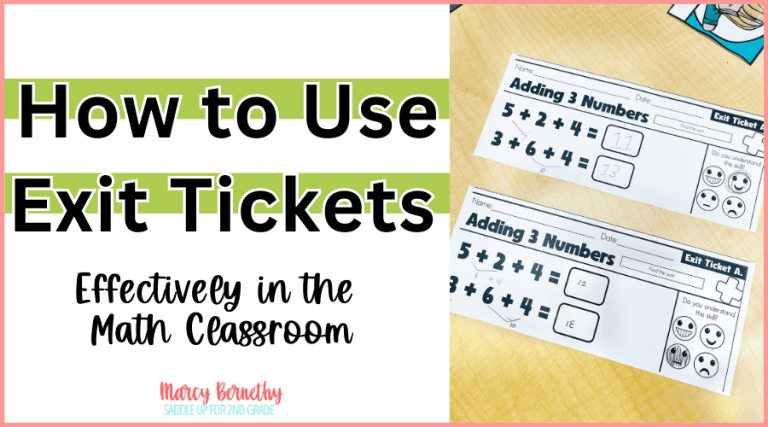

Join me for a FREE, Guided Math workshop to discover how to easily incorporate Guided Math into your current schedule!
How many times as a teacher have you heard the phrase “spiral review?” It seems like administrators are always talking to teachers about the importance of reviewing previous concepts with students, and I 100% agree with them! Our students NEED to practice previously taught skills consistently in order to master them, retain information, and build on those skills. However, the big question is, how do you spiral review skills effectively? The answer is… with math centers! Read on to learn helpful tips on how to implement math centers for spiral review with any curriculum you have!
This post contains affiliate links. You can see my disclosure here.

Math centers (or math stations as I like to call them), are a crucial part of your daily math instruction. Math stations are one component of the guided math framework that reinforces previously taught math skills while incorporating movement, teamwork, and student independence.
This is done with hands-on activities, games, and even digital math activities that keep students engaged, on task, and reviewing previous skills, all while having fun!
Oftentimes, teachers that I work with think that incorporating math stations into their instruction sounds amazing, but they aren’t sure how to make it work with their current math curriculum.
However, math centers are not a curriculum. They are one part of the guided math framework, which is a format for how you structure and run your math block WITH your curriculum.
If you’re curious about how to implement the entire guided math framework with any curriculum, check out this blog post.
It doesn’t matter if you use a math curriculum like Go Math or Eureka Math, or supplement with materials like my guided math curriculum, math stations can be implemented with ANY of them.
Check out this step-by-step guide on how to implement math centers for daily spiral review.
Want to watch it instead? Check out my YouTube video below!
When you begin implementing math stations into your day for spiral review, you first need a plan. You can’t just throw out random activities in a tub and expect it to work and keep your students engaged.
In order to make the most out of your math stations and guided math groups, you need a solid plan. Effective planning is the key to making sure your math centers run smoothly so you can dedicate your attention to the small groups at your teacher table.
When making your plan, think about the skills you want your students to spiral review and what types of math centers activities you want to use. Consider the materials that you have on hand, how much time you have, how many students will be in each group, and what your students’ interests are.
Inside of my Guided Math Binder, there is a page where you can map out your math stations for the week and month. This not only helps with planning, but it also comes in handy when you want to look back at it year after year to see what activities you used and liked.
I follow a simple format for setting up my guided math groups and math centers. There are many different systems out there, but I found a simple way that works for me and several other teachers that I’ve taught inside of my guided math course, Managing Math Stations.
With the format that I teach, guided math groups consist of 3 math centers, a technology station, and a teacher table.
Math center #1 always focuses on math facts. In the primary grades, students need continuous practice with basic math facts in order to reach mastery.
At the beginning of the year, this center will start with basic math facts. As the year progresses, you can make it more challenging by increasing the numbers or alternating between addition and subtraction facts. If you’re a 3rd grade teacher, you can use this math center to practice multiplication and division facts.
Want to grab 5 FREE math fact games that you can incorporate in this math station? Fill out the form below to get them sent straight to your inbox!
Next up, math centers #2 and #3 are always a spiral review of previously taught skills, as well as the technology center.
The only time students should practice the current skill being taught is at the small group teacher table. The teacher table is the magical place where your core instruction takes place.
This is where you focus on the current skill your curriculum is teaching and tailor your instruction to the level of the students in your group. This allows you to differentiate instruction to meet the needs of ALL students.
Just think about it, your math station activities should be something that your students can work on independently so you can focus on the students at the teacher table instead of answering questions and providing a ton of support to your other students.
If you are just introducing the concept of telling time to the minute, you wouldn’t want to put a telling time to the minute activity in your math centers! This is where I see so many teachers get caught up and frustrated.
The key to making math stations work is to wait until your students have mastered the concept to put it in a center for them to work on independently.
After you’ve set up your different guided math groups and centers, it’s time to choose your math centers activities! You always want to expose your students to a wide variety of activities.
I like to use the CPA approach for mathematics when thinking about math stations. CPA stands for Concrete, Pictorial, and Abstract.
When choosing math station activities, think about what you want your students to work on and HOW you want them to work on it. Do you want them to work with concrete, hands-on activities or more pictorial activities? Do you want them to practice more abstract thinking and problem-solving?
Once you determine this, you can choose your activities accordingly. I know that it’s easy to get caught up in the bright colors and freshly laminated math games, but it doesn’t have to be complicated. Your center activities can be simple and use basic materials, and still be highly effective. In fact, I encourage you to keep it simple!
You can even use pieces of your curriculum in your math stations, such as problem-solving practice, the curriculum workbook, digital activities, or supplemental hands-on activities.
I prefer my math centers to be more hands-on, so I like to include a variety of manipulatives and allow students to solve problems on whiteboards or in their math journals. I also like to use task cards, games, interactive notebooks, and fun math crafts to incorporate a mix of concrete, pictorial, and abstract activities.
When thinking about what types of activities to include in your math centers, there are a few things to keep in mind.
You don’t want the activities to be too difficult since students will be working independently. You also want them to be self-explanatory and have simple, easy-to-follow instructions. The more challenging your activities are, the more likely it is that you are going to have interruptions at the small group table. Use simple tasks that students can figure out on their own with little explanation.
If you’re looking for straightforward, hands-on math centers with student instructional videos showing students EXACTLY how to complete the activities, check out my Maximize Your Math Block Math Centers for 2nd Grade!
Since your students are going to be at various skill levels, use activities that will allow for easy differentiation to ensure that everyone is able to participate and be successful working independently.
You can use the same activity but differentiate it using different numbers, different task cards, or whiz dice with higher numbers.

When it comes to implementing math centers with your curriculum, my best piece of advice is to just get started! Sit down and plan out your math stations using a variety of activities that are not all the same. You don’t want each guided math group to be working on task cards. Mix it up and have fun with it!
Math centers aren’t about focusing on the curriculum. They’re about engaging students in meaningful spiral review activities that they can complete independently while giving you the time to focus on the students at your small group teacher table. Check out these 5 reasons why your students should be doing math stations!
If you’re looking for math centers activities and resources to help you get set up for success, check out these resources below!
For more helpful blog posts about math stations, check out the links below:

Math should be fun, not stressful. Ditch the timed math fact tests and replace them with math games that will help your students learn and retain information more effectively.
© Saddle Up for 2nd Grade • Website by KristenDoyle.co


